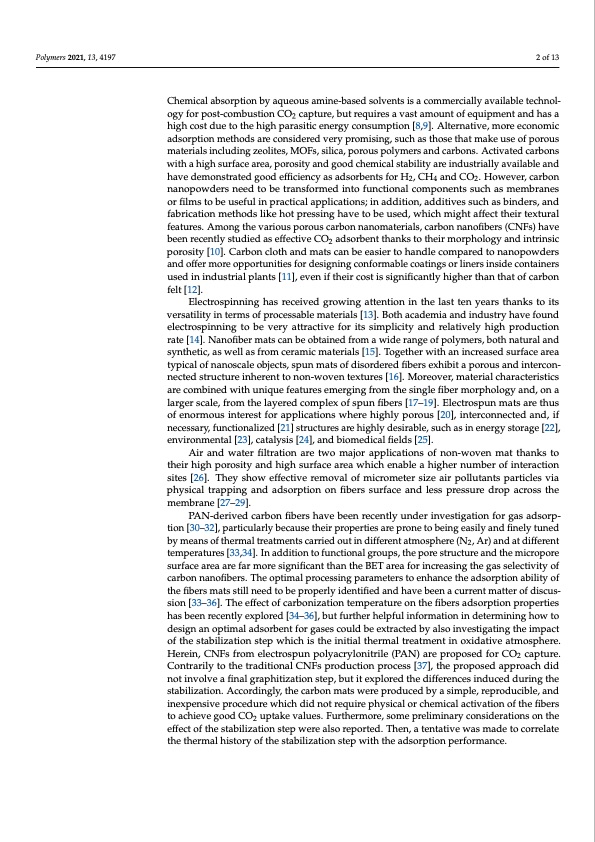
PDF Publication Title:
Text from PDF Page: 002
Polymers 2021, 13, 4197 2 of 13 Chemical absorption by aqueous amine-based solvents is a commercially available technol- ogy for post-combustion CO2 capture, but requires a vast amount of equipment and has a high cost due to the high parasitic energy consumption [8,9]. Alternative, more economic adsorption methods are considered very promising, such as those that make use of porous materials including zeolites, MOFs, silica, porous polymers and carbons. Activated carbons with a high surface area, porosity and good chemical stability are industrially available and have demonstrated good efficiency as adsorbents for H2, CH4 and CO2. However, carbon nanopowders need to be transformed into functional components such as membranes or films to be useful in practical applications; in addition, additives such as binders, and fabrication methods like hot pressing have to be used, which might affect their textural features. Among the various porous carbon nanomaterials, carbon nanofibers (CNFs) have been recently studied as effective CO2 adsorbent thanks to their morphology and intrinsic porosity [10]. Carbon cloth and mats can be easier to handle compared to nanopowders and offer more opportunities for designing conformable coatings or liners inside containers used in industrial plants [11], even if their cost is significantly higher than that of carbon felt [12]. Electrospinning has received growing attention in the last ten years thanks to its versatility in terms of processable materials [13]. Both academia and industry have found electrospinning to be very attractive for its simplicity and relatively high production rate [14]. Nanofiber mats can be obtained from a wide range of polymers, both natural and synthetic, as well as from ceramic materials [15]. Together with an increased surface area typical of nanoscale objects, spun mats of disordered fibers exhibit a porous and intercon- nected structure inherent to non-woven textures [16]. Moreover, material characteristics are combined with unique features emerging from the single fiber morphology and, on a larger scale, from the layered complex of spun fibers [17–19]. Electrospun mats are thus of enormous interest for applications where highly porous [20], interconnected and, if necessary, functionalized [21] structures are highly desirable, such as in energy storage [22], environmental [23], catalysis [24], and biomedical fields [25]. Air and water filtration are two major applications of non-woven mat thanks to their high porosity and high surface area which enable a higher number of interaction sites [26]. They show effective removal of micrometer size air pollutants particles via physical trapping and adsorption on fibers surface and less pressure drop across the membrane [27–29]. PAN-derived carbon fibers have been recently under investigation for gas adsorp- tion [30–32], particularly because their properties are prone to being easily and finely tuned by means of thermal treatments carried out in different atmosphere (N2, Ar) and at different temperatures [33,34]. In addition to functional groups, the pore structure and the micropore surface area are far more significant than the BET area for increasing the gas selectivity of carbon nanofibers. The optimal processing parameters to enhance the adsorption ability of the fibers mats still need to be properly identified and have been a current matter of discus- sion [33–36]. The effect of carbonization temperature on the fibers adsorption properties has been recently explored [34–36], but further helpful information in determining how to design an optimal adsorbent for gases could be extracted by also investigating the impact of the stabilization step which is the initial thermal treatment in oxidative atmosphere. Herein, CNFs from electrospun polyacrylonitrile (PAN) are proposed for CO2 capture. Contrarily to the traditional CNFs production process [37], the proposed approach did not involve a final graphitization step, but it explored the differences induced during the stabilization. Accordingly, the carbon mats were produced by a simple, reproducible, and inexpensive procedure which did not require physical or chemical activation of the fibers to achieve good CO2 uptake values. Furthermore, some preliminary considerations on the effect of the stabilization step were also reported. Then, a tentative was made to correlate the thermal history of the stabilization step with the adsorption performance.PDF Image | Effect of Thermal Stabilization on PAN-Derived Electrospun Carbon Nanofibers

PDF Search Title:
Effect of Thermal Stabilization on PAN-Derived Electrospun Carbon NanofibersOriginal File Name Searched:
polymers-13-04197-v2.pdfDIY PDF Search: Google It | Yahoo | Bing
Sulfur Deposition on Carbon Nanofibers using Supercritical CO2 Sulfur Deposition on Carbon Nanofibers using Supercritical CO2. Gamma sulfur also known as mother of pearl sulfur and nacreous sulfur... More Info
CO2 Organic Rankine Cycle Experimenter Platform The supercritical CO2 phase change system is both a heat pump and organic rankine cycle which can be used for those purposes and as a supercritical extractor for advanced subcritical and supercritical extraction technology. Uses include producing nanoparticles, precious metal CO2 extraction, lithium battery recycling, and other applications... More Info
| CONTACT TEL: 608-238-6001 Email: greg@infinityturbine.com | RSS | AMP |